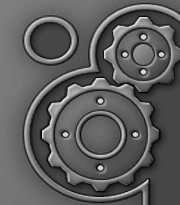Simply put, Portraits are representations or delineations of a person or animal. However, most of us think of portraits as an image of a persons face. Something that shows, represents or portrays their personality. Often we think of portraits as the artistís way of capturing the personís essence. This used to be the goal of sculptures and painters before photography was ever around.
Is that though, the only form of a portrait? After all, we know that a presidential portrait is a portrait because itís in the name. We also know that a passport photograph is a portrait even though we donít like to think of it that way. The question I would like to ask is how much of the portrait is about the person and how much is about the artist and the viewers?
I read once that portraits are about the artists and their interpretation of the subject. That is to a large extent true in that the artist usually chooses the position, lighting and camera angle. In a 1970ís photography book, I found a section that explained that a classic family portrait pose is to have the male looking at the camera to show power and control over their environment. The female should look away ďpensivelyĒ to show calmness and serenity and the children should look innocent and peaceful. As far as I can tell, once the family has been positioned in that way you have already taken a lot out of the portrait. The pose speaks more about the artists and viewerís interpretation of what they want the family to be rather than seeing what they really are. Incidentally, I once saw a portrait of a Lion, Lioness and two cubs that followed this format and it was outstanding. Probably because that is how we want to see the king of the jungle. In reality, most people I know who have been to safaris have a lot less respect for the lionís role in the animal kingdom.
How to get started:
The first thing to do is not to pick up the camera and start shooting. Instead go through some old photographs and pull out some portraits that are successful and some that are not. Write down some notes on what makes them work or fail. Also show them to your photography friends and get their opinions.
Next, look in magazines and gooks for other examples of portraits. Try to figure out what the photographer did and why. With all of this new found knowledge you should have an idea of what the rules are for portraits.
Now you can pick up your camera and photograph. What you want to do is take some images that follow the rules. Then take some that break one or two rules at a time. Finally try and break all the rules.
Once you get the final images, look at them and see which ones are successful. You may be the sort of person that likes the ones that follow all the rules. Or you may be like me find breaking the rules more effective. Either way it is a mater of personal style and preference. Take some more notes on these new images to identify what you find to he good and bad in each one.
Finally try to use this new found knowledge to constantly improve and explore new ideas in portraiture. After all the Human face is a landscape that can tell a lot about the subject, the photographer and world they live in.



 Simply put, Portraits are representations or delineations of a person or animal. However, most of us think of portraits as an image of a persons face. Something that shows, represents or portrays their personality. Often we think of portraits as the artistís way of capturing the personís essence. This used to be the goal of sculptures and painters before photography was ever around.
Simply put, Portraits are representations or delineations of a person or animal. However, most of us think of portraits as an image of a persons face. Something that shows, represents or portrays their personality. Often we think of portraits as the artistís way of capturing the personís essence. This used to be the goal of sculptures and painters before photography was ever around.